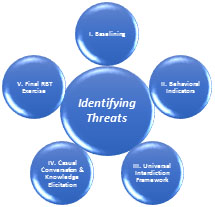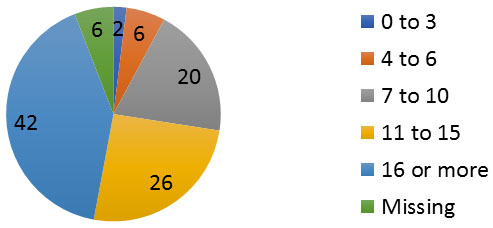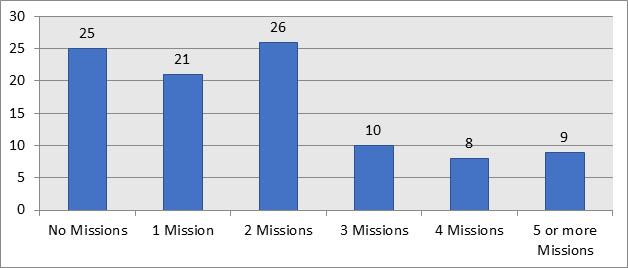Threat Assessment Training for Peacekeepers: A Proven Business Approach
Nathan Meehan
Introduction
In conflicts involving terrorism and asymmetric warfare, peacekeepers are subject to threats ranging from person-borne improvised explosive devices to criminals and insurgents. Peacekeepers need the ability to distinguish threats from the larger population they are meant to protect. Through early identification, preemptive action to a threat can reduce the need to use force, decrease the likelihood that the observer or civilian will suffer injury, and facilitate the protection of human rights.
Between 2013 and 2017, United Nations (UN) peacekeeping personnel experienced a consistent increase in fatalities (Santos Cruz, Phillips, & Cusimano, 2017). Through the Improving Peace and Securities Project, the UN, seeking to better understand the problem, commissioned a team led by Retired Lieutenant General Santos Cruz to study it and make recommendations. In the Santos Cruz report, the project team made a variety of recommendations on how to reduce peacekeeping personnel fatalities and injuries from acts of violence.
In their report, Santos Cruz et al. (2017) described the need for a low-technology tool which allows UN personnel to more quickly and efficiently understand the patterns of behavior in their location, allow them to distinguish potential threats, and react appropriately. This will, in-turn, allow peacekeepers to better protect themselves and safely interact with civilian populations. Such a tool was developed as part of the Just Doesn’t Look Right (JDLR) Project and was transitioned from research to practice through the Identifying Threat in Peacekeeping Environments (Identifying Threats) program. [i]
Through the Identifying Threats program, a team of US trainers and researchers trained Uruguayan military personnel on threat assessment techniques through a partnership with Global Peace Operations Initiative and the Peace Operations Training Center of Uruguay (ENOPU). The purpose of this train-the-trainer program was to enhance the capability of peacekeepers to identify and appropriately react to behavioral indicators of threat. The original US team trained 102 personnel, 7 coaches, and 6 instructors at ENOPU. With this internal capacity, ENOPU trainers went on to train 19 officers and 190 enlisted personnel (ENOPU, 2018). Trainees have been deployed to UN peace operations in Haiti (MINISTAH), the Sinai, and the Democratic Republic of Congo (MONUSCO). The techniques have also been used domestically by the Uruguayan Army including in the provision of perimeter security to prisons and at international border checkpoints (ENOPU, 2018).
The goal of this paper is to describe the Identifying Threats program and its application to peacekeeping throughout the partnership ENOPU. We will present information on the project, the training program, available assessment and evaluation data, and potential relevance to the recommendations made in the Santos Cruz report. It is not meant as a critique of the Santos report nor UN peace operations policy.
The Santos Cruz Report
The Santos Cruz report was published in December 2017. The researchers analyzed a variety of data from UN internal sources and interviews with more than 160 personnel (Santos Cruz et al., 2017). There has been a substantial and sustained increase in fatalities tied to the UN missions in Darfur (UNAMID), South Sudan (UNMISS), and Mali (MINUSCA). These injuries and fatalities were generally a result of small arms fire and the fatalities were mostly from formed military units (Santos Cruz et al., 2017). A substantial majority of attacks against UN personnel occurred outside bases while on patrol and during attacks on defensive perimeters of UN bases. The project team provides a series of recommendations to reduce injuries and fatalities among UN peacekeepers.
As part of the report, Santo’s Cruz et al. (2017) encourages the UN and troop-contributing countries to take a variety of steps to operate in the more dangerous environments of Darfur, Sudan, and Mali. There are 4 areas of recommendations: changing mindsets, improving capacity, achieving a threat sensitive mission footprint, and enhancing accountability (Santos Cruz et al., 2017).
While it is outside the scope of this paper to fully describe the large number of recommendations of the Santos Cruz report, the Identifying Threats program is a tool which could help to achieve recommendations related to changing mindsets and improving capacity. Changing mindsets involves ensuring that peace operations personnel are “aware of risks and empowered to take the initiative to deter, prevent, and respond to attacks” (Santos Cruz et al., 2017:10). Associated with this change in mindset comes a recommendation for UN peacekeepers to become more proactive in their own defense and to identify and eliminate threats. Improving capacity involves ensuring that “personnel are equipped and trained to operate in high-threat environments, and that missions have the assets to and procedures necessary to deter attacks and limit fatalities and injuries that occur” (Santos Cruz et al., 2017: 10). The authors recommend expanded pre-deployment training to prepare troops to work in hostile environments and take a proactive posture to base security.
A host of activities are required to implement these two larger recommendations. The threat identification techniques of the Identifying Threats program can be used to support implementation of the Santos Cruz recommendations. These techniques will assist the UN and troop and police contributing countries to better prepare their personnel to effectively operate in complex environments.
The Identifying Threats Program
Identifying Threats is a 40-hour instructor-led train-the-trainer program involving classroom instructions, role-playing activities, and reality-based training. The current version of the training is tailored for platoon leaders and senior non-commissioned officers deployed to MONUSCO. These personnel are the primary individuals interacting with civilians while on a mission. It is a supplement to existing pre-deployment training with its focus on using visual and verbal behavior to identify threats as well as the decision-making process associated with assessing threats.
The basis for the Identifying Threats program was the Just Doesn’t Look Right (JDLR) Project. The goal of the JDLR Project was to identify and articulate behavioral indicators associated with deceit, threat, fear of detection, or the carrying of concealed weapons. These indicators were derived from law enforcement methods to identify persons carrying guns, being deceptive, or otherwise involved in suspicious or illicit activities (Meehan et al., 2015A; Meehan & Strange, 2015; Meehan & McClary, 2015; Meehan et al., 2015B). The intent of the project was to transfer this knowledge from police and military experts to less experienced military personnel and better prepare them for complex environments.
The training program was developed through a partnership between the JDLR Project team, US Southern Command Global Peace Operations Initiative, ENOPU and their support of the UN mission in the Democratic Republic of Congo (DRC). In early 2018, Uruguay is one of the largest South American troop-contributing countries to United Nation's missions (UNDPKO, 2018). They have supported UN missions across the globe and most recently in the DRC and Haiti (UNDPKO, 2018). UN missions are complex, and peacekeepers must interact with unarmed civilians and armed combatants. In the DRC, of particular concern is the pervasive presence of weapons among the civilian population and the need for techniques to better distinguish those who are about to use their weapons from those who are merely carrying them. During a series of focus groups in 2015 with the project team, Uruguayan junior officers and training staff also stated the need for baseline assessment training to help them better understand crowd behavior and group dynamics, as well as improved techniques to interview and converse with the populace and armed combatants.
The foundation of Identifying Threats is a systematic observation process. This process was developed to allow an observer (in this case a peacekeeper) to assess consistent behavior in a given environment. This systematic assessment of behavior enables the observer to identify behavioral deviations. These deviations lead to the identification of suspicious or threatening individuals. It is important to note that this process allows the observer to filter a potential threat from the broader population and provides a focus for further observation and interdiction. Observation and threat assessment are weaved into all stages of an encounter with a potentially suspicious or threatening person.
The five training modules include: 1) baselining techniques, 2) identification and understanding of types of behavioral indicators, 3) learning a standardized process for interdiction through the Universal Interdiction Framework, 4) casual conversation with knowledge elicitation techniques, and culminates with 5) a series of reality-based training exercises.

In the train-the-trainer format, the training gradually increases the student involvement as the class progresses. In Uruguay, this three-step process occurred in 5 deliveries over 18 months. First, the trainees attend the program as a student. From this class, students volunteered and were then selected to return as a coach. Coaches are not instructors; they support the instructors in their delivery of the training by assisting in lectures and exercises. After successfully working as a coach, specific individuals then return to help as instructors-in-training. In this third delivery, the trainee works with and is observed by trained instructors to deliver segments of the training. After successful execution of the third delivery, these individuals become instructors. The final two deliveries in Uruguay involved Naval Research Lab instructors observing and supporting entirely Uruguayan deliveries.
The Identifying Threats training was developed as a proof-of-concept to apply JDLR Project research and transition this knowledge to military personnel. The program provided Uruguayan military personnel with an actionable set of tools to utilize during their interaction with the population during peace operations.
Evaluating Identifying Threats
Through the transition of the Identifying Threats program to ENOPU, a variety of data was collected which allows us to get a better understanding of receptivity and effectiveness of the program. Only select data is reported in this manuscript.
Program trainees were a diverse group. Most of our trainees were Lieutenants (45.1%) and Sergeants (37.2%), with some Captains (17.6%). Figure 1 describes the years of military experience for trainees across all five deliveries. While we had a large range of experience levels, more than half the trainees had 11 or more years of time in the military.

Figure 1: Years of Military Experience (N=102)
Prior mission experience for each delivery is described in Figure 2.

Figure 2: Prior Missions (N=99)[ii]
Most trainees supported missions in the DRC and Haiti. As Figure 2 indicates, the range of mission experience varies, but the largest subset had no mission experience (24.5%) or had been on one or two missions (46.1%). However, there were a number of students with significant mission experience with 16.7% having completed four or more missions. One attendee had been on eight prior missions; interestingly this individual became a member of our instructional cadre and worked as a coach.
There are a variety of methods to evaluate the effectiveness of training. The Kirkpatrick (1998) model has been a highly-cited and widely-influential foundation for thinking about the evaluation of training since its inception several decades ago. There are four generally accepted levels of evaluation. They include:
- Level 1: Reaction – what trainees say about their experience;
- Level 2: Learning - what measurable changes can we attribute to success;
- Level 3: Behavior - how well can trainees perform their job; and
- Level 4: Results – to what extent has the program brought the sponsoring organization closer to its goal (Kirkpatrick, 1998).
Data is available which allows us to explore trainee reaction to the material (Level 1) and more limited data on measurable changes in trainee capability (Level 2). Regretfully, at the current time and due to the loss of funding for the project, we do not have data which allows us to assess Level 3 and Level 4 results.
Self-reported assessments (Level 1 data) are overwhelmingly positive. Across all deliveries, 100% of all attendees agreed that the skills they learned will support their ability to do their job.
We also collected a variety of data on self-reported skill assessments (Level 2 data). Trainees were asked on a scale of 1-5 about their understanding of specific concepts before and after the training; with 1 being the lowest level of understanding and 5 being the highest. Across all five deliveries, trainees self-reported a substantial improvement in their skills.
The self-assessments on the ability to analyze an environment, identify behaviors associated with contraband or weapons carrying, and identify a threat in their presence are included in Figure 3.

Figure 3: Self-Reported Skill Changes (N=102)
Generally, starting with rating their general understanding of a specific topic as a 2 of 5 (I have heard of this but don’t know much about it) to a 4 (I am comfortable with this topic and could easily complete the task). This is a significant increase in-self reported knowledge gain.
While trainees self-reporting knowledge gain (Level 1 evaluation) is important, more objective measures are also necessary to explore the viability of this training program. In the fifth and final delivery of the transition, participants completed a skill assessment (Level 2 evaluation). This provided an objective source of data. The purpose of the skills assessment was to measure the increase in capabilities due to the training. In this assessment, trainees had to successfully identify a potential person of interest (POI) who posed a threat to themselves or others. This assessment was a classic pre-post-test where participants were given the same style of task for both the pre-assessment and post-assessment. In both the pre and post-test, the trainees observed a video scenario and coded what they observed. It should be noted; this delivery was fully instructed by Uruguayan staff.
The pre-test was given in the morning on Day 1 and the post-test was taken at the end of Day 5. In the pre-test, only 1 out of 24 participants was able to successfully identify the POI. In the post-assessment, 12 participants were able to correctly select the POI. This represents a significant improvement in the trainees’ ability to identify a suspicious person.
Overall, the benefits of the training, both in a self-reported knowledge gain and in a skill-based assessment, show support for the utility of the Identifying Threats techniques to peace operations in complex environments. Despite this data, more systematic follow-up with trainees and the collection of Level 3 and Level 4 evaluation data would help us to better understand how these techniques were used during a peace operation and if they resulted in safer conditions and interventions with potential threats.
Relevance to the Santos Cruz Report and Conclusion
Through the Identifying Threats program, we trained almost three hundred Uruguayan sergeants, lieutenants, and captains in research-based threat identification techniques. They went on to support peace operations in Haiti and the DRC. Trainees with significant military and mission experience were highly receptive to the training and associated threat identification techniques. For example, in the fifth and final delivery of the transition nearly 70% of the trainees volunteered to become an Identifying Threats coach. The successful transition and continued delivery of the training by ENOPU also speak to the utility of the program.
General Santos Cruz and this team make many different recommendations to reduce fatalities among UN personnel. The Identifying Threats program is a low technology tool that could be of benefit to the efforts of the Improving Peace and Securities Project and General Santos Cruz and his team, specifically, in their efforts to make peace operations personnel more proactive and more prepared to operate in complex environments.
We recognize that peace operations and the work of the uniformed military and police contingents are complex. The solution to these conflicts is not a military one (Haeri, 2018) and as these political, social, and civil solutions are established, it is up to the military and police to keep the peace in these potentially dangerous situations.
We hope that the research conducted under the auspices of the JDLR project and put into practice through the Identifying Threats program can be of use to any military, civilian, or police personnel providing services in complex environments. We must use all tools at our disposal to protect those who keep the peace.
Works Cited
Dos Santos Cruz, C. F, Phillips, W. R., & Cusimano C. (2017). Improving Security of United Nations Peacekeepers: We need to change the way we are doing business. The Improving Security Peacekeeping Project. Accessed April 2, 2018 at https://peacekeeping.un.org/sites/default/files/improving_security_of_united_nations_peacekeepers_report.pdf.
Haeri, D. (2018). The Global Observatory. Strengthening UN Peacekeeping: Placing the Santos Cruz Report in Context. Accessed April 10, 2018 at https://theglobalobservatory.org/2018/02/strengthening-peacekeeping-cruz-report-context/.
Kirkpatrick, D. (1998), Evaluating Training Programs: The Four Levels (San Francisco: Brett-Koehler Publishers).
Meehan, N., McClary, M., & Strange, C. (2015A). Behavioral Indicators of Drug Couriers in Airports. Memorandum Report - NRL/MN/5508--15-9595. United States Naval Research Laboratory.
Meehan, N. and McClary, M. (2015). Behavioral Indicators of Drug Carriers in Open Spaces. Memorandum Report - NRL/MN/5508--15-9596. United States Naval Research Laboratory.
Meehan, N. & Strange, C. (2015). Behavioral Indicators of Legal and Illegal Gun Carrying. Memorandum Report. United States Naval Research Laboratory.
Meehan, N., C. Strange, & McClary, M. (2015B). Behavioral Indicators during a Police Interdiction. Memorandum Report - NRL/MN/5508--15-9598. United States Naval Research Laboratory.
Peace Operations Training Center of Uruguay (ENOPU). (2018). Mobil Training Team Report on the Identifying Threats in Peacekeeping Environments Training Course. Unpublished manuscript.
United Nations Department of Peacekeeping Operations (UNDPKO). (April, 2018). Troop and Police Contributors. Retrieved from https://peacekeeping.un.org/en/troop-and-police-contributors.
End Notes
[ii] Missing data resulted in a reduced sample size.
About the Author(s)
Comments
Tu publicación es bastante…
Tu publicación es bastante agradable. Los juegos de fútbol han demostrado que no solo son la joya de la corona en el mundo real sino también en el universo del entretenimiento interactivo, a pesar de que los juegos deportivos son uno de los géneros más populares en todas las plataformas. Para saber más sobre Los 5 mejores juegos de futbol - Colgados por el Futbol lee mi https://colgadosporelfutbol.com/los-5-mejores-juegos-de-futbol/ blog. Decidimos reconocer los mejores juegos de fútbol en Android y al mismo tiempo tener en cuenta los juegos que superan la norma en términos de juego competitivo.
